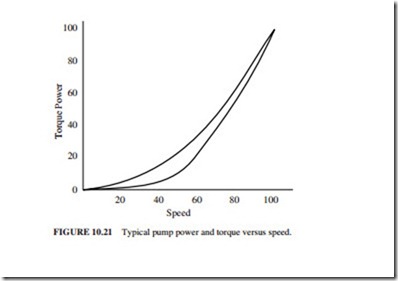REGENERATION
During normal drive operation, the power is supplied to the VSD, then to the motor, and then to the load. Most of the energy is dissipated in the process, and the remainder is stored in load. A rotating load can be slowed down and energy removed from it and returned to
the ac power line (regeneration). This is done by lowering the synchronous speed below the actual mechanical speed of the load (magnetic break). The amount of magnetic braking and power generation is proportional to the difference between the synchronous speed and actual mechanical speed. In the extreme case, the motor can be “plugged” (stopped almost instantly) by reversing the leads to any two phases; e.g., the synchronous speed of a two- pole motor is switched from 3600 to -3600 rpm instantly. These are the power flow diagrams during normal operation and regeneration:
If the cost of energy can be tolerated, the machine can coast down, dissipating its energy to the atmosphere. Mechanical brakes can be used to slow down the machine by convert- ing the mechanical energy to heat. However, if the machine must be slowed down quickly or the cost of lost energy is high (e.g., frequent slowdown of large inertia), regeneration is required. These are some examples:
Dynamometer
These devices are used to test engines and transmissions. The dynamometers are used to load up the engine or transmission to determine its performance. Since regeneration is used to feed the mechanical energy in the load back to the power supply, the only power consumed is the losses in the system. In the past, a mechanical brake (water-cooled) was used for this function. The cost of lost energy in this case would be significant for dynamometers rated more than a few hundred horsepower.
Paper Machine Winder
This application has a very high load inertia (a few hundred times larger than the rotor inertia). The load must be started and stopped frequently as new rolls of paper are made. Brakes are needed to prevent the reels from coasting for a long time. In the past, water-cooled mechanical brakes were used to slow down the winder. Tremendous energy is lost in this process. The VSD can regenerate this energy back to the ac line. The only losses in this process are the ones that occur in the drive itself (2 to 3 percent of its rated output).
Dynamic Braking
In a dynamic brake, the mechanical energy in the load is dissipated in a water- or air-cooled resistor bank as shown:
The resistor bank is installed across the dc bus inside the VSD. It is switched in when the link voltage rises above a preset limit. It remains on until the voltage drops below the pre- set limit. This braking method is used when the amount of energy that can be regenerated back to the ac line is not very large or the retrieval of energy is done very infrequently. This option costs about 10 percent of regeneration.


